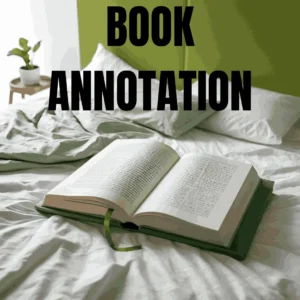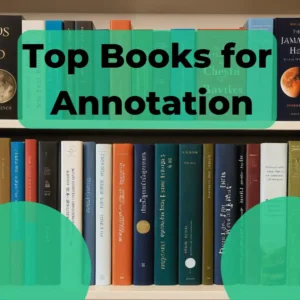Introduction: Unlock a New Level of Reading Insight
If you’ve mastered the basics of book annotation and are ready to dive deeper, you’re in the right place. Whether you’re a lifelong reader or someone who’s recently started annotating, taking your annotations beyond the basics will completely transform how you engage with books
This guide will walk you through advanced book annotation methods that will allow you to gain a richer, more nuanced understanding of any text.
We’re not just talking about underlining sentences or jotting notes in the margins—we’re exploring thematic annotations, multi-layered interpretations, and critical analysis that will deepen your reading experience. Let’s get started.
1. Thematic Annotations: Exploring Core Ideas Across a Text

When you’re dealing with complex or lengthy works—think of epic novels, historical texts, or deep non-fiction—it’s easy to lose track of key themes. Thematic annotation helps you focus on a particular theme or idea as it develops across the text.
How to Do It:
- Choose a theme before you start reading (e.g., power, love, freedom).
- Assign a color or symbol specifically for that theme.
- As you read, highlight or annotate each passage that relates to the theme.
This method helps you follow thematic threads and understand how the author develops these ideas throughout the book. For example, while reading a novel like 1984 by George Orwell, you might track themes like control, surveillance, and freedom. Your annotations will serve as a roadmap of how these themes intertwine to form the book’s message.
Why It Works:
Thematic annotation not only improves comprehension but also gives you a framework for critical analysis, making it an ideal technique for both pleasure and academic readers.
2. Multi-Layered Annotations: Interpreting the Text from Different Perspectives

One of the most valuable techniques for deep readers is multi-layered annotation. This involves reading a book multiple times (or revisiting key sections) and adding annotations with a different focus each time.
How to Do It:
- First Layer: Focus on the surface-level content—plot points, key information, and personal reactions.
- Second Layer: On a second read-through, annotate for character development, literary techniques, or author’s intent.
- Third Layer: Focus on symbolism, themes, or historical context. Make connections between different parts of the text.
This method works exceptionally well for complex texts like Moby Dick or The Brothers Karamazov, where the story offers new insights with each reading.
Why It Works:
Multi-layered annotation helps uncover deeper meanings that may not be obvious at first glance. You develop a richer understanding by analyzing different elements like language, structure, and symbolism in multiple stages.
3. Critical Annotations: Engage with the Author’s Argument
If you’re reading non-fiction or scholarly work, critical annotations allow you to question, agree with, or challenge the author’s argument. This active engagement makes your reading more interactive and thought-provoking.
How to Do It:
- Question the Author: Ask yourself whether you agree with the author’s viewpoint. Mark passages where you feel the argument is weak or incomplete.
- Cross-reference: Annotate connections to other works, ideas, or arguments you’ve read. This is particularly useful when reading academic papers, essays, or philosophical texts.
- Summarize: In your own words, rewrite sections you found difficult to understand or summarize key points. This helps solidify your comprehension.
Why It Works:
Critical annotations sharpen your analytical skills. They push you to interact with the material in a meaningful way, going beyond passive reading.
4. Digital Annotation Tools: Enhance Your Reading Experience

In today’s world, many readers have turned to digital platforms like Kindle, Google Play Books, or apps like Notion for their annotations. Digital annotation comes with its own set of advantages, especially for advanced readers.
Why Use Digital Tools:
- Cross-referencing: You can hyperlink between annotations and different parts of the text, creating an interconnected map of your thoughts.
- Easy to search: Digital tools allow you to search your annotations for specific keywords or themes.
- Organize your thoughts: You can easily categorize and export your annotations for future reference.
Top Tools for Digital Annotation:
- Kindle Highlights and Notes: Syncs across devices and allows for easy retrieval of key points.
- Good Notes or Notion: Ideal for organizing thoughts and linking multiple layers of notes.
5. Personalization: Make Annotations Truly Your Own

One of the joys of advanced annotation is personalization. Whether you’re annotating for pleasure or academic purposes, your annotations are unique reflections of your thoughts and interpretations.
How to Personalize:
- Use different colors, symbols, or even doodles to express your thoughts.
- Include personal reflections: How does a particular passage resonate with your life experiences or current events?
- Write a brief summary of each chapter or section in the margins.
Why It Works:
Personalized annotations not only make the reading experience more enjoyable but also create a personal connection to the text. Over time, you’ll build a treasure trove of notes that reflect your evolving thoughts and understanding.
Conclusion: Take Your Book Annotation to the Next Level
By integrating these advanced annotation techniques, you can transform your reading from a passive activity into a deeply engaging and enriching experience. Whether you’re following themes, adding layers of meaning, or questioning the text critically, each method allows you to interact with books on a whole new level.
So, grab your highlighters, sticky notes, or digital devices, and start annotating like a pro! The more you practice, the more rewarding your reading journey will become.
Have you tried any advanced annotation techniques? Share your experiences in the comments below or tag us on social media with your favorite annotated book. Let’s start a conversation on how we can make reading more interactive and insightful!



